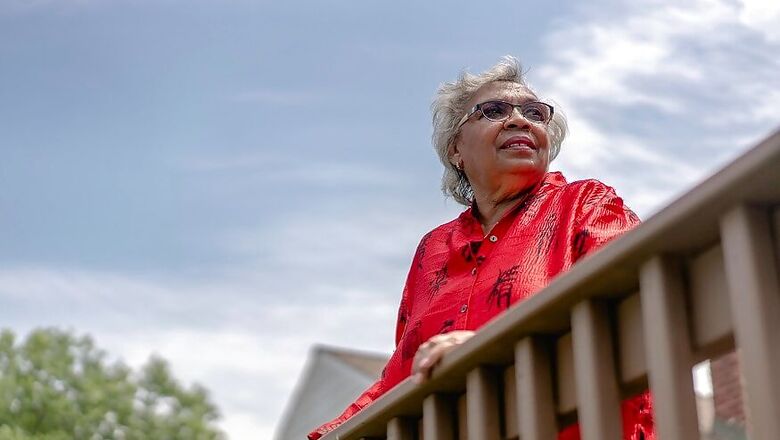
views
Joan Murray had been home with COVID-19 for about a week when she ran into trouble. She had a fever of 103 degrees and chills that sent shivers up and down her spine. Her oxygen levels were dropping, and the tightness in her chest felt “as if somebody had bound up my lungs with string.”
But the 77-year-old, a retired registered nurse who lives alone in Westbury, New York, was adamant that she wanted to fight the illness at home. “As a nurse, maybe I knew too much,” she said. “The last place I wanted to be was the hospital.”
So the hospital came to her.
Northwell Health, which has cared for thousands of coronavirus patients in its network of facilities in New York state, sent a nurse manager to Murray’s home in May. Covered head to toe in protective gear — gown, gloves, mask, shield and disposable bootees — she spent nearly eight hours doing an assessment.
Murray was dehydrated and in need of supplemental oxygen. Within hours, she was hooked up to an intravenous line, set up in her bedroom to replenish her fluids. A phlebotomist in an N95 mask came to draw blood, an oxygen machine was delivered to her home, and Murray was prescribed a powerful blood thinner to prevent clots.
Over the course of the next week, nurses dropped by every day, and a Northwell critical care physician and lung specialist, Dr. Gita Lisker, called daily to talk with Murray.
“I was always waiting for her call — I would tell her all my troubles, and she would reassure me,” Murray said. “I was like a child at that point, and she was my security blanket.”
So-called wraparound home care services were created, on the fly, by Northwell Health to deal with the surge in coronavirus cases that New York experienced this spring. Now this model may help relieve health systems in the Sun Belt and other parts of the United States, where rising numbers of cases are putting extraordinary pressure on hospitals, filling intensive care units and sending providers scrambling to hire extra nurses and secure medical supplies.
Northwell doctors are already discussing the program with physicians in Miami, where several hospitals have reached capacity. Florida has more than 300,000 COVID-19 cases, and more than 10,000 new cases were identified on Thursday.
The concept of hospital-at-home programs is not new, but they had been used primarily to treat patients with flare-ups of chronic conditions like heart failure.
In response to the coronavirus epidemic, Medicare relaxed the requirements for such care. Now patients are considered homebound if a medical practitioner advises them not to leave the home because of a diagnosis of confirmed or suspected COVID-19 or a condition that makes them more susceptible to contracting the virus.
In those situations, if a doctor says skilled services are needed, a home health agency can provide them under the Medicare Home Health benefit, officials said.
Since the start of the pandemic, some hospitals have switched to at-home services to open up hospital beds for COVID-19 patients or to provide follow-up care after COVID-19 patients are discharged from the hospital.
Northwell’s outreach is different because it focuses on acutely ill COVID-19 patients in the community. A team of Northwell specialists uses telehealth to advise doctors and patients in the community with mild or moderate illness.
When necessary, a comprehensive health service sends nurses and equipment into the homes of patients with severe symptoms or underlying medical conditions who might need hospitalisation without such close monitoring. Pulmonologists use telemedicine to follow these patients.
During New York’s crisis, “80 to 90% of the patients who had the virus never went to the hospital,” said Dr. Thomas McGinn, Northwell’s senior vice president and deputy physician-in-chief, who helped create the program.
Many COVID-19 patients did not need to be hospitalised, while others — including some who would have been admitted — simply refused to go, he said: “Hospitals were becoming this place that scared everybody.”
With a shortage of diagnostic tests, many sick patients were afraid that if they didn’t already have the virus, they’d catch it at the hospital. And they were put off by the knowledge that they’d be cut off from friends and family, because visitors had been barred from health facilities to prevent further spreading of the virus.
At first, physicians were nervous about managing patients at home, McGinn and Lisker said. Since then, experts have learned a lot and have developed evidence-based protocols that rely on educating patients on how to monitor their temperature fluctuations, track their blood oxygen levels using pulse oximeters and report changes to their health care providers.
Pulmonologists, experienced in caring for very sick patients with lung disease, consulted with patients over the phone, Lisker said.
“I can have a phone conversation with a patient, and after the first two sentences, I can tell if they’re going to have respiratory problems,” she said. “We’re trained to listen.”
Any patient in respiratory distress would be hospitalised, she added. But most patients were able to ride out their illnesses at home.
Between April 27 and June 1, Northwell enrolled 182 patients in its home care program. They ranged in age from 24 to 100, and many had underlying chronic conditions like diabetes or obesity, which have been linked to worse outcomes in COVID-19 cases.
Several, like Murray, were older and lived alone. But they had been carefully screened by their regular doctors; only two eventually needed hospitalisation, Lisker said.
Roni Caryn Rabin c.2020 The New York Times Company




















Comments
0 comment